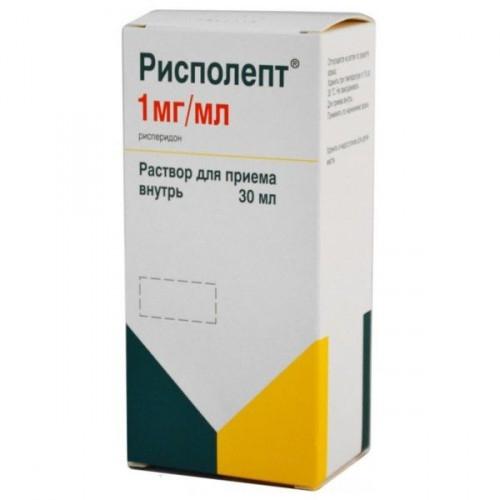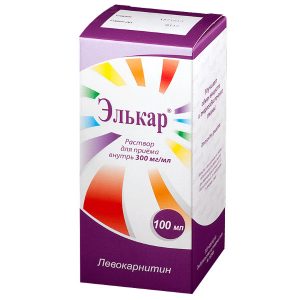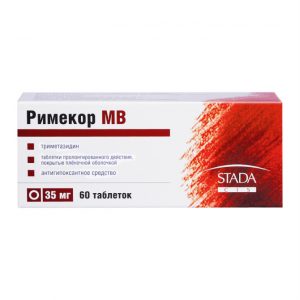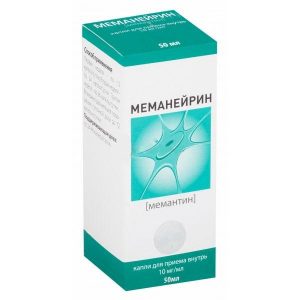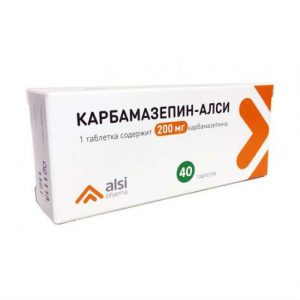Description
Release form
Oral solution
Packaging
30 ml
Pharmacological action
Rispolept is an antipsychotic drug derived from benzisoxazole. It also has a sedative, antiemetic and hypothermic effect.
Risperidone is a selective monoaminergic antagonist, has high affinity for serotonin 5-HT2 and dopamine D2 receptors. It binds to β1-adrenergic receptors and is somewhat weaker – to histamine H1 receptors and β2-adrenergic receptors. It has no tropism for cholinergic receptors.
Antipsychotic effect due to blockade of dopamine D2 receptors of the mesolimbic and mesocortical system. Sedative effect is due to blockade of adrenoreceptors of the reticular formation of the brain stem antiemetic effect – blockade of the dopamine D2 receptors of the trigger zone of the vomiting center hypothermic effect – blockade of the dopamine receptors of the hypothalamus.
Risperidone reduces the productive symptoms of schizophrenia (delirium, hallucinations), aggressiveness, automatism, to a lesser extent, suppresses motor activity and to a lesser extent induces catalepsy, than classic antipsychotics. Balanced central antagonism of serotonin and dopamine can reduce the tendency to extrapyramidal side effects and expand the therapeutic effect of the drug on the negative and affective symptoms of schizophrenia.
Risperidone may cause a dose-dependent increase in plasma prolactin concentrations.
Pharmacokinetics
Absorption
After oral administration, risperidone is completely absorbed from the gastrointestinal tract. Cmax in plasma is reached after 1-2 hours. Food does not affect the absorption of the drug, so Rispolept can be prescribed regardless of food intake.
Distribution
Risperidone is rapidly distributed in the body. Vd is 1-2 l / kg. In plasma, risperidone binds to albumin and alpha-1-glycoprotein. Risperidone is 88% bound to plasma proteins, 9-hydroxy-risperidone – 77%.
Css risperidone in the body in most patients is achieved within 1 day.
Css 9-hydroxy-risperidone is achieved within 4-5 days. The concentration of risperidone in plasma is proportional to the dose of the drug (within therapeutic doses).
Metabolism
Risperidone is metabolized in the liver with the participation of the CYP2D6 isoenzyme to form 9-hydroxy risperidone, which has a pharmacological effect similar to risperidone. Risperidone and 9-hydroxy-risperidone constitute the active antipsychotic fraction. Another route of risperidone metabolism is N-dealkylation.
Excretion of
After oral administration in patients with psychosis, T1 / 2 of risperidone from plasma is about 3 hours. T1 / 2 of 9-hydroxy-risperidone and the active antipsychotic fraction are 24 hours.
After a week of taking the drug, 70% of the dose is excreted in the urine, 14% – with feces. In urine, risperidone plus 9-hydroxy-risperidone make up 35-45% of the dose. The remaining amount is inactive metabolites.
Pharmacokinetics in special clinical cases
In elderly patients and in patients with renal failure after a single oral administration, higher plasma concentrations and delayed excretion of risperidone were observed.
In patients with hepatic insufficiency, the concentration of risperidone in the plasma did not change.
Indications
Management of acute attacks and long-term maintenance therapy: acute and chronic schizophrenia and other psychotic disorders with productive and negative symptoms of
affective disorders in various mental illnesses
behavioral disorders in patients with dementia with symptoms of violent aggression) , impaired activity (agitation, delirium) or psychotic symptoms of
behavior disorders in adolescents from 15 years old and adult patients with Reductions intellectual level or mental retardation in cases where destructive behavior (aggression, impulsivity, autoaggression) is leading the clinical picture of the disease.
To stabilize mood in the treatment of mania in bipolar disorders (as a means of adjuvant therapy).
Contraindications
lactation (breastfeeding)
hypersensitivity to the components of the drug.
Caution is advised to use in patients withcardiovascular system (including chronic heart failure, myocardial infarction, conduction disturbances), dehydration, hypovolemia, cerebrovascular accident, Parkinson ² ¢s disease, seizures (including a history of), severe renal or liver failure, with drug abuse or drug dependence, in conditions predisposing to the development of pirouette type tachycardia (bradycardia, electrolyte imbalance, concomitant medication drugs that prolong the QT interval), with brain tumors, intestinal obstruction, in cases of acute overdose of drugs, with Reye’s syndrome (because the antiemetic effect of risperidone can mask the symptoms of these conditions), during pregnancy, in patients under 15 years of age (i.e. to. safety and efficacy of the drug have not been established).
Use in pregnancy and lactation
Safety Pregnancy has not been studied. Risolept can be used during pregnancy only if the positive effect justifies the possible risk. Since risperidone and 9-hydroxy-risperidone pass into breast milk, women using Rispolept should not breast-feed.
Special instructions
Caution is advised to use the drug in patients with diseases of the cardiovascular system (including heart failure, myocardial infarction, cardiac muscle conduction disorders), as well as dehydration, hypovolemia or cerebrovascular disorders. In this category of patients, the dose should be increased gradually.
The risk of developing orthostatic hypotension is particularly increased in the initial period of dose selection. If hypotension occurs, consider reducing the dose.
When using drugs that have the properties of antagonists of dopamine receptors, the occurrence of tardive dyskinesia, characterized by involuntary rhythmic movements (mainly of the tongue and / or face), was noted. There are reports that the occurrence of extrapyramidal symptoms is a risk factor for the development of tardive dyskinesia. Rispolept causes extrapyramidal symptoms to a lesser extent than classical antipsychotics. If symptoms of tardive dyskinesia appear, consider discontinuing all antipsychotic drugs.
When using classical antipsychotics, cases of the occurrence of central nervous system are described, which is characterized by hyperthermia, muscle rigidity, instability of autonomous functions, impaired consciousness and an increase in the level of CPK. In the case of the development of ZNS, it is necessary to cancel all antipsychotic drugs, including Risolept.
Caution should be given to Rispolept for patients with Parkinson’s disease, since in theory this can cause a worsening of the course of this disease.
Classical antipsychotics are known to lower the seizure threshold. Given this, Risplept is recommended with caution in patients with epilepsy.
Rispolept has an effect primarily on the central nervous system, therefore it should be used with caution in combination with other centrally acting drugs.
During treatment, patients should be advised to refrain from overeating due to the possibility of increasing body weight.
Composition
Active ingredient: risperidone 1 mg.
Excipients: tartaric acid benzoic acid sodium hydroxide purified water
Dosage and administration of
A. Schizophrenia
Adults and children over 15 years of age. Risolept can be appointed once or twice a day.
The initial dose of Rispolept is 2 mg per day. On the second day, the dose should be increased to 4 mg per day. From this point on, the dose can either be maintained at the same level or individually adjusted if necessary. Usually the optimal dose is 4-6 mg per day. In some cases, a slower dose increase and lower initial and maintenance doses may be warranted.
Doses above 10 mg per day have not shown higher efficacy compared to lower doses and may cause extrapyramidal symptoms. Due to the fact that the safety of doses above 16 mg per day has not been studied, doses above this level cannot be used.
Benzodiazepines can be added to Rispolept therapy if additional sedation is required.
Information on the use for the treatment of schizophrenia in children under 15 years of age is not available.
Elderly patients. An initial dose of 0.5 mg twice daily is recommended. The dosage can be individually increased by 0.5 mg twice a day to 1-2 mg twice a day.
Diseases of the liver and kidneys. An initial dose of 0.5 mg per dose 2 times a day is recommended. This dose can gradually be increased to 1-2 mg per dose twice a day.
Drug abuse or drug dependence – the recommended daily dose of the drug is 2-4 mg.
B. Behavioral disorders in patients with dementia
An initial dose of 0.25 mg twice daily is recommended. If necessary, the dosage can be individually increased by 0.25 mg 2 times a day, not more often than every other day. For most patients, the optimal dose is 0.5 mg twice daily. However, some patients are shown taking 1 mg 2 times a day.
Once an optimal dose is reached, a once-daily dose may be recommended. srdlk
Drug abuse or drug dependence – the recommended daily dose of the drug is 2-4 mg.
B. Behavioral disorders in patients with dementia
An initial dose of 0.25 mg twice daily is recommended. If necessary, the dosage can be individually increased by 0.25 mg 2 times a day, not more often than every other day. For most patients, the optimal dose is 0.5 mg twice daily. However, some patients are shown taking 1 mg 2 times a day.
Once an optimal dose is reached, a once-daily dose may be recommended. srdlk
Drug abuse or drug dependence – the recommended daily dose of the drug is 2-4 mg.
B. Behavioral disorders in patients with dementia
An initial dose of 0.25 mg twice daily is recommended. If necessary, the dosage can be individually increased by 0.25 mg 2 times a day, not more often than every other day. For most patients, the optimal dose is 0.5 mg twice daily. However, some patients are shown taking 1 mg 2 times a day.
Once an optimal dose is reached, a once-daily dose may be recommended. srdlk no more than every other day. For most patients, the optimal dose is 0.5 mg twice daily. However, some patients are shown taking 1 mg 2 times a day.
Once an optimal dose is reached, a once-daily dose may be recommended. srdlk no more than every other day. For most patients, the optimal dose is 0.5 mg twice daily. However, some patients are shown taking 1 mg 2 times a day.
Once an optimal dose is reached, a once-daily dose may be recommended.
B. Bipolar disorder with mania
The recommended initial dose of the drug is 2 mg per day at a time. If necessary, this dose can be increased by 2 mg per day, not more often than every other day. For most patients, the optimal dose is 2-6 mg per day.
D. Behavioral disorders in patients with mental retardation or with a predominant destructive tendency in the clinical picture
Patients weighing 50 kg or more – the recommended initial dose of the drug is 0.5 mg once a day. If necessary, this dose can be increased by 0.5 mg per day, not more often than every other day. For most patients, the optimal dose is 1 mg per day. However, for some patients, 0.5 mg per day is preferable, while some require an increase in dose to 1.5 mg per day.
patients, weighing less than 50 kg – The recommended initial dose of the drug is 0.25 mg once a day. If necessary, this dose can be increased by 0.25 mg per day, not more often than every other day. For most patients, the optimal dose is a dose of 0.5 mg per day. However, for some patients, 0.25 mg per day is preferable, while some require an increase in dose to 0.75 mg per day.
Long-term administration of Rispolepta in adolescents should be carried out under the constant supervision of a physician.
Use in children under 15 years of age is not recommended.
Side effects of the
From the nervous system: insomnia, agitation, anxiety, headache, sometimes drowsiness, fatigue, dizziness, impaired attention, blurred vision, rarely – extrapyramidal symptoms: tremor, rigidity, hypersalivation, bradykinesia, acute bradykinesia, dystonia.
In patients with schizophrenia – hypervolemia (either due to polydipsia or due to the syndrome of inadequate secretion of antidiuretic hormone), tardive dyskinesia (involuntary rhythmic movements of the tongue and / or face), neuroleptic malignant syndrome (hyperthermia, muscle rigidity, instability of autonomous functions, impaired consciousness and an increase in the level of creatine phosphokinase), thermoregulatory disorders and epileptic seizures.
From the digestive system: constipation, dyspepsia, nausea or vomiting, abdominal pain, increased activity of liver enzymes, dry mouth, hypo-or hypersalivation, anorexia, increased appetite, increased or decreased body weight.
From the cardiovascular system: orthostatic hypotension, reflex tachycardia, increased blood pressure. Against the background of Rispolept therapy, the development of strokes is described, mainly in elderly patients with predisposing factors.
From the hemopoietic organs: neutropenia, thrombocytopenia.
From the endocrine system: galactorrhea, gynecomastia, menstrual irregularities and amenorrhea. In very rare cases, hyperglycemia and exacerbation of preexisting diabetes mellitus have been reported in patients.
From the genitourinary system: priapism, erectile dysfunction, ejaculation disorders, anorgasmia, urinary incontinence.
Allergic reactions: rhinitis, rash, angioedema, photosensitivity.
From the skin: dry skin, hyperpigmentation, itching, seborrhea.
Other: arthralgia
Drug Interactions
Given that Rispolept ® primarily affects the central nervous system, it should be used with caution in combination with other centrally acting drugs and with alcohol.
Rispolept ® reduces the effectiveness of levodopa and other dopamine agonists.
Clozapine reduces risperidone clearance.
When using carbamazepine, a decrease in the concentration of the active antipsychotic fraction of Rispolept in plasma was noted. Similar effects can be observed when using other inducers of hepatic enzymes.
Phenothiazines, tricyclic antidepressants, and certain -adrenoblockers can increase plasma risperidone concentrations, but this does not affect the concentration of the active antipsychotic fraction.
Fluoxetine may increase the concentration of risperidone in plasma, but to a lesser extent the concentration of the active antipsychotic fraction.
When applying Rispolept together with other drugs that bind to plasma proteins to a high degree, there is no clinically pronounced displacement of any drug from the protein fraction of plasma.
Antihypertensive drugs – the severity of a decrease in blood pressure increases with risperidone.
overdose
Symptoms: are already known pharmacological effects of the drug in the intensified form – drowsiness, sedation, tachycardia, arterial hypotension, extrapyramidal symptoms. Up to 360 mg of the drug has been reported. The data obtained suggest a wide range of drug safety. In rare cases, an overdose of QT has been observed with an overdose.
In the case of acute overdose in combination therapy, the possibility of involvement in the symptomatic effects of several drugs should be considered.
Treatment: The airway should be maintained and maintained to ensure adequate oxygen supply and ventilation, gastric lavage (after intubation, if unconscious) and administration of activated charcoal with laxative. ECG monitoring should be started immediately to detect possible arrhythmias.
No specific antidote exists, appropriate symptomatic therapy should be performed. Arterial hypotension and vascular collapse should be eliminated in / in fluid infusions and / or sympathomimetic drugs. In case of acute extrapyramidal symptoms, anticholinergic drugs should be prescribed. Continuous medical monitoring and monitoring should continue until the symptoms of intoxication have disappeared.
Storage Conditions
The product should be stored at 15 ° C to 30 ° C.
shelf life
3 years
Deystvuyushtee substance
Risperidone
Terms and conditions
prescription
Possible product names
RISPOLEPT 0.001 / ML 30ML RR D / VN PRIM
RISPOLEPT 0, 001 / ML 30ML FLAC RR D / BH PRIM
Rispolept 1mg / ml 30ml
Rispolept 1mg / ml solution for oral administration 30ml Fl. X1 B M (R)
RISPOLEPT RR INTERNAL 1MG / ML 30ML No. 1
Janssen Pharmaceutical N.V., Belgium
